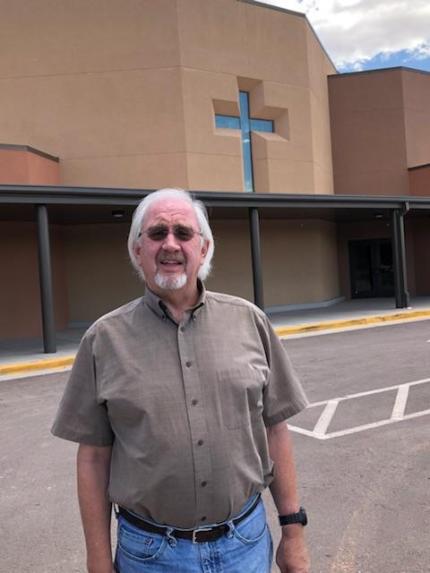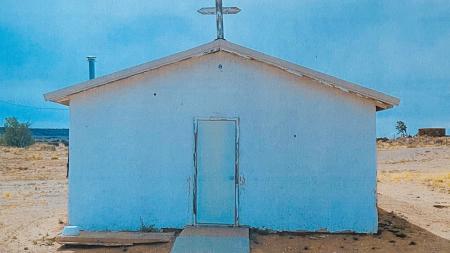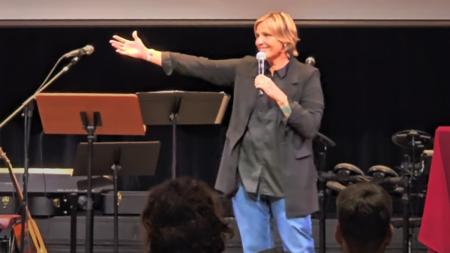Red Mesa: Growing Leadership and Learning to Trust the Holy Spirit

Moses Chung
After worshipers at Red Valley (Ariz.) Christian Reformed Church finished singing hymns in Navajo from the Living Praise Hymnal (Jesus Woodlaaji Sin), Pastor Caleb Dickson stepped to the pulpit to give the sermon.
A soft wind from outdoors ruffled the curtains in the sanctuary, in which about 25 people sat in chairs listening to Dickson.
The topic of his sermon that morning was “Suffering for God” — a topic familiar to many in the sanctuary that morning in late July.
“There are things God does and allows to happen in our lives that make us wonder,” said Dickson, who was ordained as a commissioned pastor in March, making him among the first Native American people to serve in this role in Classis Red Mesa. Among other things, his ministry exemplifies the growth, focus, and significance of the Red Mesa Leadership Training Network (LDN) that he studied with and that has been raising up Indigenous leaders and pastors for the past 10 years.
Being from the Nez Perce nation, as well as having studied through the LDN, Dickson knows the hardships people face and is well aware of the context in which he serves.
In his sermon he reminded worshipers: “We don’t live on easy street. . . . The Christian life involves things we don’t understand — and yet later, when we pray and seek God’s counsel, some of these things become more apparent,” said Dickson.
Dickson’s sermon was rough and real; it touched on the book of Esther and how God uses people, often mysteriously, for his purposes.
“Suffering will prove and improve our faith,” said Dickson. “In suffering, we learn to persevere so that we can be preserved by God. And as we suffer, we can learn to help others in their suffering.”
In many ways this subject connected with and spoke deeply to the history that a number of church members have experienced. They live in an area of red-rock mesas and mountains in which the U.S. government opened uranium mines in the 1940s.
People here were poor, many of them working as shepherds or farmers, so getting a job in the mines, with higher pay, was attractive.
But the government didn’t make clear how dangerous it was to work with uranium, and the miners received few protections. As decades passed, the effects on the miners from Red Valley and elsewhere on the Navajo reservation became clear as they got sick and began dying from lung cancer and other respiratory diseases.
The legacy of that time endures. People here know what it means for the promise of good work to turn to disaster. As their pastor, Dickson gears his ministry to people whose hopes have been broken, sometimes by outside groups, and yet whose faith survives.
“We pray that Red Valley will pick up new growth. We have to help those who are sick and getting older,” Dickson said. “We can’t let the Word of God leave this area. We need to keep the children of the next generation in our prayers.”
Birth of LDN
In many ways, the Red Mesa LDN is a living example of the Spirit at work; it has helped to bring new life to struggling churches on the Navajo reservation.
But it took time to unfold.
Rev. Stanley Jim, a Navajo working as an ethnic ministry leader for Christian Reformed Home Missions (now part of Resonate Global Mission), saw the need in 2000 or so for a program to train Indigenous leaders on the Navajo reservation and beyond. He realized that Home Missions, which had been supporting churches in Red Mesa for many years, was in the process of determining its priorities and how it funded ministries.
This meant to Stanley Jim that churches in Red Mesa, and on other reservations, had the chance to look at their future and consider training their own Indigenous pastors and leaders.
Finally about 10 years ago, after much work by such people as Jim and Ruth Bennally and others, the LDN was developed and up and running.
Now offering a three-year program, the LDN meets twice a month, alternating between Rehoboth (N.Mex.) CRC and Maranatha Fellowship CRC of Farmington, N.Mex. About 30 people, most middle aged or older, have graduated from the program over the past decade.
How LDN Has Changed Lives
About two hours after the worship service at Red Valley, Caleb Dickson and his wife, Alice, joined a group of others involved in the LDN for a meeting at Bethel CRC in Shiprock, N.Mex.
Numbering about 20, they came from across the area on this Sunday afternoon to talk and share stories about their involvement in the program.
They also spoke of how, guided by the Holy Spirit, pastors, elders, deacons, and others have taken greater ownership of their churches.
“We realized we needed to step out of our comfort zones and be servants of the Lord and build up the churches in Classis Red Mesa,” said Alice Dickson.
The others who had gathered around a conference room table at Bethel CRC agreed: people who had been on the sidelines in their churches had begun to see that they needed to join in the Holy Spirit’s work to stabilize and grow the churches in Red Mesa. So far, the going has been slow; many churches are poor and have a hard time paying their pastors.
Still, the LDN is providing a scaffolding for these leaders.They have the support and confidence they need to do the work of ministry. Learning more about the Bible and especially how it and the teachings of the CRC apply in Red Mesa is both challenging and satisfying.
“The church is at a crossroads today, and we can be part of helping to develop a strategic way of proclaiming the good news of Christ in a time when young people aren’t coming,” said Janelia Smiley, an LDN student and member of Bethel CRC.
It wasn’t long before people around the table also began to talk about their faith and life experiences, helping to characterize the context in which they work in the LDN program.
For instance, Smiley said her father was a Navajo medicine man whose wisdom and things he taught are also in the book of Proverbs. She added that he always told her “everything is holy.”
Evelyn Bennally recalled her work as a teacher in the Red Valley area for several years and — along with her husband, Willie — being active in the church Dickson now serves.
A few years ago, Ray Slim, now deceased but then the pastor of Sanostee CRC and one of the first LDN teachers, asked Evelyn and Willie to consider taking over for him when he retired. They resisted at first — but he kept after them, and eventually they agreed. “We knew the Lord was calling us,” Evelyn said.
The Bennallys were able to obtain licenses to preach in the CRC through the LDN. Taking over from Slim, they faced a range of challenges. It was unclear, for example, how many people were truly members in good faith at the church.
On Sundays, the few people who attended worship left as soon as the benediction was given. Hard feelings over long-ago hurts festered. Memories apparently lingered about funding from Home Missions, by then no longer available, that had help keep the church afloat.
“We asked for help from our relatives, from our clan,” said Bennally, referring to the Navajo extended family with which she is affiliated. “We also began going deep into the Heidelberg Catechism and asked people to reaffirm their faith or be baptized and make a profession of faith.”
Elsie Reed, a leader at Sanostee CRC, said the church began to slowly turn around and work through the process of becoming an organized CRC congregation.
“As we did this and brought people back together, we also had to work on forgiveness. We would meet for prayer and pray for the church and for the congregation — and that’s where the Holy Spirit came in,” she said. “It has taken time, but even financially we’re getting there.”
Influenced in one way or another by the LDN, churches in Red Mesa have been making their congregations their own as they follow the lead of the Spirit.
Looking ahead to his ministry work in Red Valley, Dickson said he knows it will be challenging, especially to gain the trust of the people in the community. Things inside and outside the church, such as neglect and broken relationships, coupled with tragedies that have befallen uranium miners and their families, have created divides.
“Ours is a congregation that has a history of pain, and we need to address the pain,” said Dickson.
Referring to himself and Alice, he said, “The Holy Spirit has sent us here to help heal people and learn how to get over all of the pain they have experienced. We know that the Holy Spirit asks us to trust and will take care of it all.”


